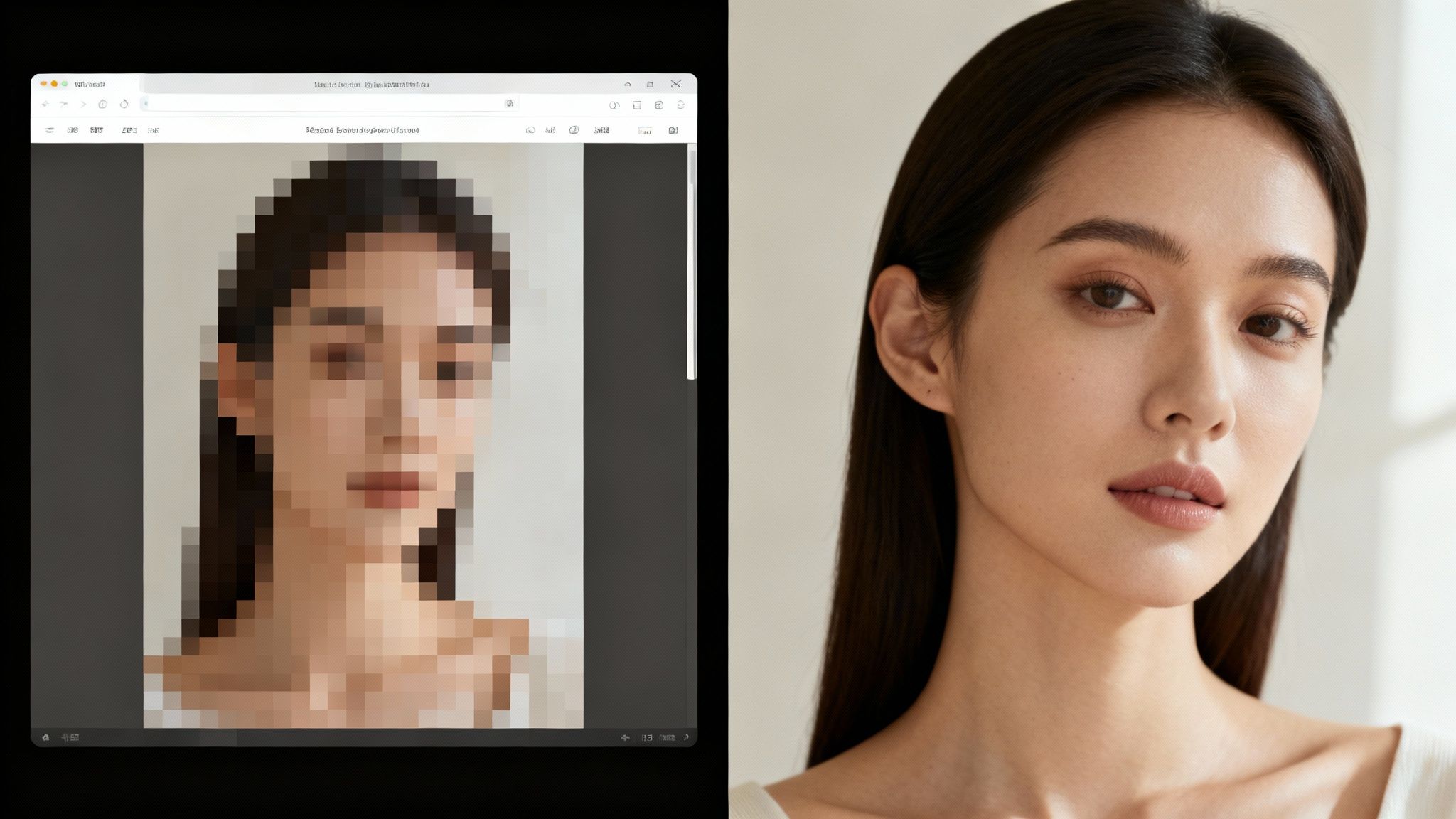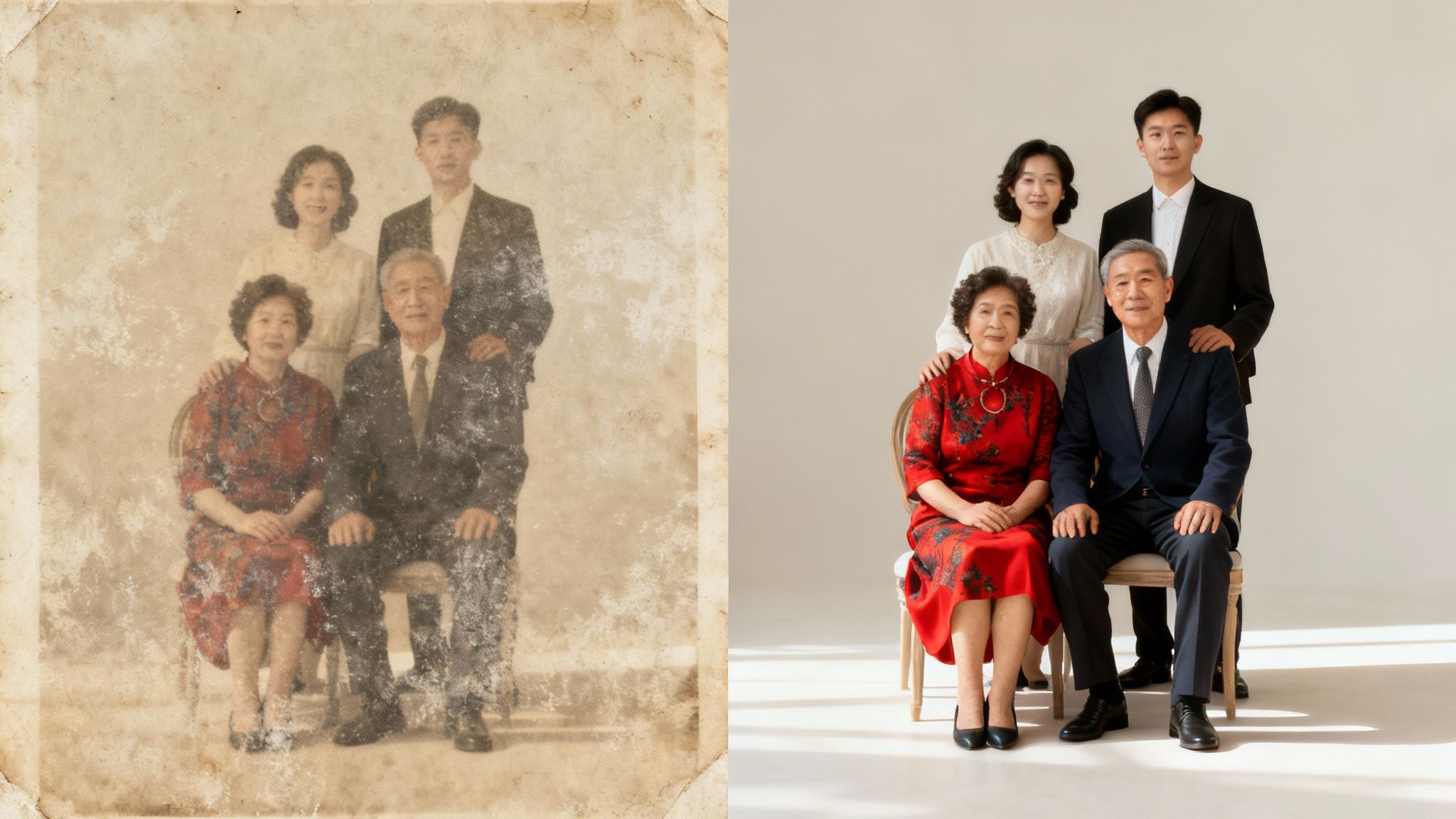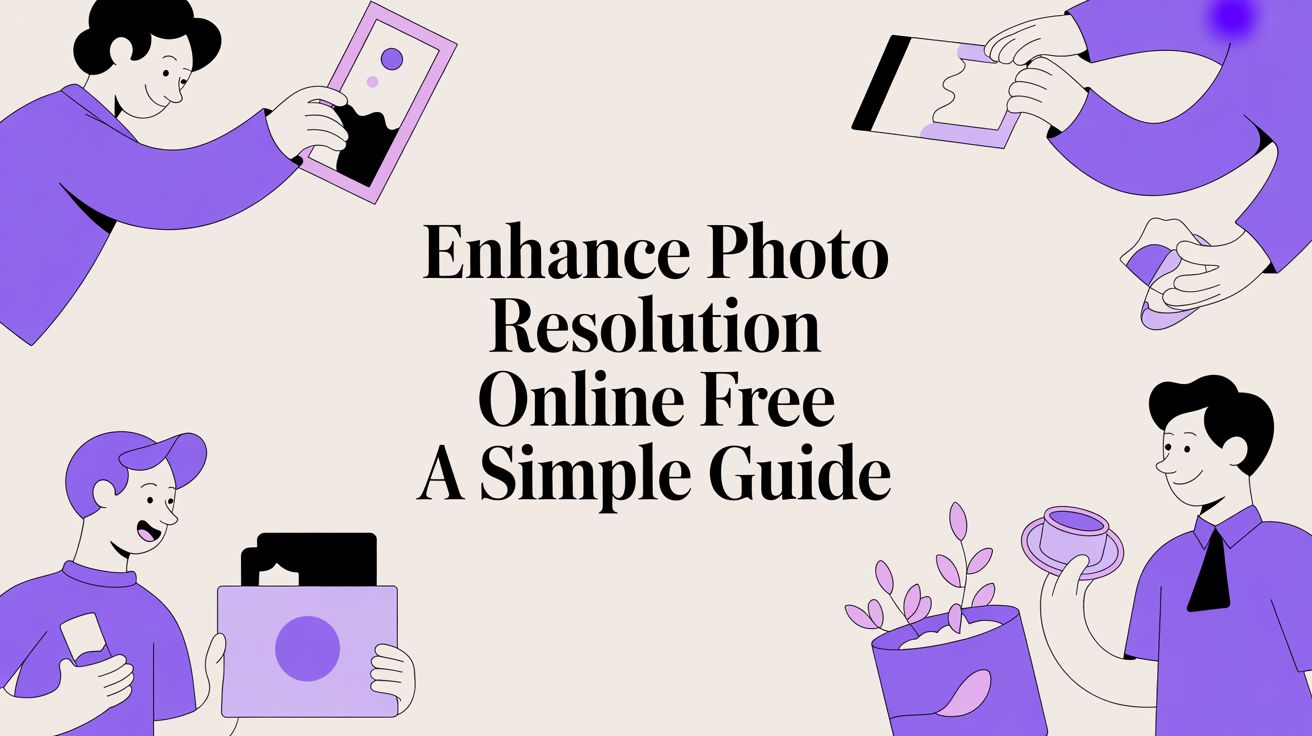Got a blurry, low-resolution photo you need to fix? You can enhance photo resolution online free using an AI-powered tool like DreamShootAI’s Magic Upscaler. These tools don't just stretch your photos; they intelligently rebuild them to add crisp details and sharpness. It’s the difference between a pixelated mess and a high-quality visual, and it only takes a few clicks.
Why Image Quality Is a Game Changer Online

In a world overflowing with visual content, the clarity of your images speaks volumes before you ever say a word. Let's be honest: low-resolution, pixelated photos aren't just a minor annoyance anymore. They’re a red flag.
Blurry images signal a lack of professionalism and can seriously damage your brand's credibility. Crisp, clear visuals have become the baseline expectation for anyone trying to build trust with an online audience. Websites with high-quality images see much lower bounce rates for a reason—when a visitor lands on a page with fuzzy product shots, their first impression is negative, and they’re likely to click away.
The Real Cost of Poor Visuals
The damage from bad images goes way beyond just looking sloppy. It hits the metrics that matter, from social media reach to actual sales. For instance, did you know that content with compelling, high-resolution images gets a whopping 94% more total views on average, according to research compiled by MDG Advertising?
As digital marketing expert Chloe Adams puts it, "Your images are the digital handshake with your audience. A blurry photo is like offering a limp, unconfident handshake—it immediately undermines trust and suggests a lack of attention to detail."
This isn't just theory; it plays out in real-world shopping habits. Studies from Justuno show that 93% of consumers consider visual appearance to be the key deciding factor in their purchasing decisions. A grainy or unclear image can be the one thing that sends a potential customer straight to a competitor. That’s a direct hit to your revenue.
AI Upscaling: The Modern Fix
Thankfully, you no longer need expensive software or a design degree to get professional-grade images. Free online tools that enhance photo resolution are leveling the playing field for everyone.
These AI platforms are designed to:
- Reconstruct Missing Detail: The AI models intelligently add new pixels and refine details that were never there, creating a natural-looking, high-resolution result.
- Boost Clarity and Sharpness: They sharpen soft edges and clean up digital noise, making the subject of your photo stand out.
- Drive More Engagement: High-quality visuals are simply more shareable. They get more likes, comments, and clicks across all social media platforms.
When you fix a blurry photo, you’re doing more than just cleaning up pixels. You’re investing in your online presence and making a stronger connection with your audience.
How AI Image Enhancers Actually Work
So, what’s the magic behind the curtain when you enhance photo resolution online free? Let's get one thing straight: this isn't your grandma's photo software that just stretched pixels until everything turned into a blurry, unusable mess.
https://www.youtube.com/embed/UorIb_rGZuc
Modern AI image enhancers are more like highly trained digital artists. They rely on complex models, often Generative Adversarial Networks (GANs), which have been taught by studying millions of high-resolution photos. Think of the AI as a forensic artist reconstructing a face from just a few key details—it uses its vast library of knowledge to fill in the blanks with stunning accuracy.
Rebuilding Reality, One Pixel at a Time
The AI isn’t just guessing. It meticulously analyzes the pixels in your low-res image—looking at colors, shapes, and patterns—and then predicts what the missing details should be based on everything it has learned.
It intelligently generates new, realistic information. This could be anything from adding fine skin texture and individual strands of hair to sharpening the edges of a distant building.
Dr. Alistair Finch, a lead researcher in computational photography, states, "AI upscaling is fundamentally about reconstruction, not just enlargement. The algorithm has learned the visual patterns of our world and uses that knowledge to generate new, plausible data that fits seamlessly into the original image."
This reconstruction is exactly why an AI-enhanced photo looks so much sharper and more detailed. The image isn't just bigger; it's a far more complete and believable version of the original. If you want to dive deeper into the nuts and bolts, this is a great read on how AI image enhancers improve image quality.
The technology has come a long way, fast. Today's best tools can deliver incredible resolution boosts up to 4K, 8K, and even 16K. This process also complements tools designed to fix other issues, something we cover in our guide on how to unblur an image effectively. The result is amazing texture and a natural look that was simply out of reach just a few years ago.
A Practical Guide to Upscaling Your First Photo
Jumping into AI photo enhancement is a lot easier than you might think. You don't need to be a tech wizard or download any complicated software to get started. Let's walk through how to take a blurry, low-resolution image and turn it into something sharp and clear using a free online tool.
The basic idea is simple: upload your photo, pick a setting, let the AI work its magic, and then download the vastly improved version. The trick is knowing which settings to use for what you need—whether it's for a crisp Instagram post or a high-quality print. This quick guide will help you enhance photo resolution online free with confidence.
Choosing the Right Upscale Factor
Your first big decision is how much to upscale the image. Most tools will give you options like 2x, 4x, or even 8x. Your choice here really depends on where the final photo is going to live.
- For Social Media (2x): A simple 2x upscale is usually all you need for platforms like Instagram or Facebook. It sharpens the details and boosts clarity without making the file so large that it takes forever to load on someone's feed.
- For Digital Displays (4x): If you're prepping an image for a website banner, a digital portfolio, or a big presentation slide, a 4x upscale is the way to go. It gives you that extra resolution needed to look sharp on larger screens.
- For Printing (4x or 8x): When you're going from screen to paper, resolution is everything. A 4x or even 8x upscale is critical to make sure your image doesn't end up looking pixelated in a frame. The higher the resolution, the cleaner the print.
This infographic breaks down just how straightforward the process is.

As you can see, the whole workflow is designed to be as direct as possible, getting rid of the technical roadblocks that used to keep everyday users from editing their own photos.
Taking the DreamShootAI Magic Upscaler for a Spin
A great place to start is with our own free tool. The DreamShootAI Magic Upscaler at https://dreamshootai.com/tools/photo-enhancer offers a clean, simple interface that lets you get right to it.
"The biggest hurdle for most people isn't the technology itself, but the perceived complexity," notes digital photography expert David Chen. "Modern AI tools have eliminated that barrier, making high-quality photo editing accessible to anyone with an internet connection."
If you're ready to explore what's out there and try upscaling for yourself, check out this great list of the top free photo enhancer tools available today. You'll find plenty of excellent options to fit whatever project you're working on.
Where Can You Use Your Upscaled Photos?

Alright, now that you’ve got the hang of upscaling, let's get into the fun part: putting those crisp, new images to work. This isn't just about fixing a blurry selfie; it's about unlocking a ton of practical and creative potential for photos you thought were unusable.
Take e-commerce, for example. We've all seen those grainy product photos that make you second-guess a purchase. A study by Salsify confirmed that 87% of shoppers rate product content and images as "extremely important" when deciding to buy. If you’re running a small online shop, you can take decent smartphone pictures of your products, run them through an upscaler, and get sharp, professional-looking images that build trust and actually drive sales.
Bringing Old Memories Back to Life
One of my favorite uses for this tech is reviving old family photos. You know the ones—scanned images from decades ago that are tiny and pixelated. Upscaling them lets you create beautiful, high-quality prints that are actually worth framing. It’s an incredible way to preserve those memories for a whole new generation.
Up Your Professional Game
Beyond personal projects, high-quality images are a must for your professional brand. That slightly blurry headshot on your LinkedIn profile? It’s not doing you any favors. A quick upscale can sharpen it right up, making you look more polished and detail-oriented.
Freelance photographer Madison Clarke agrees, noting, "The facial feature enhancement is impressively natural... The 4K upscaling really makes my shots pop with great detail."
And if you're looking for a total refresh, you might even consider a professional AI headshot generation service to create a set of consistent, studio-quality options from scratch.
To give you a clearer picture of what a difference upscaling makes, I've put together a quick comparison table. This shows how a typical low-resolution photo transforms at different upscale levels.
Image Upscaling Results Comparison
| Upscale Level |
Resulting Dimensions |
Approximate File Size |
Best For |
| 2x Upscale |
1200 x 800 pixels |
~500 KB |
Social media posts, blog images |
| 4x Upscale |
2400 x 1600 pixels |
~1.5 MB |
Website banners, digital portfolios |
| 8x Upscale |
4800 x 3200 pixels |
~5 MB |
High-quality printing, large displays |
As you can see, even a simple 2x upscale makes an image much more versatile for online use, while an 8x upscale prepares it for professional printing without losing quality.
A Tool for Artists and Marketers
Artists and designers can get a ton of mileage out of this, too. If you create digital art at a lower resolution, you can easily upscale the final piece to get it ready for high-quality prints, merchandise, or your online portfolio. The AI fills in the details so your work looks just as amazing on a big canvas as it does on your screen. Suddenly, your art is more versatile and easier to monetize.
Common Mistakes to Avoid When Enhancing Photos
Knowing how to enhance photo resolution online free is one thing, but getting consistently great results means knowing what not to do. I’ve seen countless people get frustrated by artificial-looking outcomes, and it almost always comes down to a few common slip-ups. Steering clear of these is your secret weapon for professional-grade quality.
One of the biggest culprits is starting with a heavily compressed image. Think about that JPEG you’ve saved over and over again. Each time, it loses a little bit of quality, creating those fuzzy digital artifacts. When you try to upscale a file like that, the AI can actually amplify those blocky imperfections, making the final image look even worse.
The fix is simple: always use the highest-quality source file you have. A PNG or an original camera file gives the AI clean data to work with, which translates into a much sharper and more natural-looking enhancement.
Overshooting The Upscale Factor
Another classic mistake is thinking bigger is always better. Trying to blow up an already large, high-resolution photo by 4x or 8x usually doesn't get you much. The AI has less to improve on, so the changes can be barely noticeable, and you just end up with a massive file that’s a pain to store and share.
Instead, be strategic. Match the upscale factor to your goal. A 2x enhancement is often perfect for social media, while a 4x is great for website banners or small prints. This targeted approach saves you time and delivers a much more effective result.
It's essential to understand that AI doesn't invent detail from thin air. It intelligently predicts and reconstructs pixels based on what it has learned from its training data. If the original image is a blurry mess with no discernible information, the AI has very little to work with, and the output will reflect that limitation.
It's no surprise that the demand for these tools is exploding. The global image recognition market, which includes AI enhancement, was valued at $25.65 billion in 2020 and is projected to reach $101.8 billion by 2028, growing at a CAGR of 16.6%. You can actually explore the full research on this expanding market to see where the technology is headed.
Setting Realistic Expectations
Finally, you have to remember that AI is powerful, but it isn't magic. Feeding it an extremely out-of-focus or tiny, thumbnail-sized image and expecting a perfectly sharp 8K photo just isn't going to happen. The tech works best when it has a reasonable starting point.
For the best results, start with an image that is at least semi-clear, even if it's on the smaller side. This gives the algorithm enough foundational detail to build upon, ensuring your final, enhanced photo looks both crisp and authentic.
Got Questions About Photo Enhancement? We've Got Answers.
Jumping into the world of online photo enhancement can feel a bit like learning a new language. What's possible? What are the limits? We hear you. Here are some of the most common questions we get, with straightforward answers to help you get the best results when you enhance photo resolution online free.
Can I Actually Make My Screenshots Look Better?
Yes, you absolutely can. AI upscalers are fantastic at sharpening up text and cleaning up the user interface elements in a screenshot. This is a lifesaver if you're putting together a presentation or a tutorial and need everything to look crystal clear.
Just keep in mind that the original screen grab still counts. If you start with a super low-res or heavily compressed image, the AI will definitely improve it, but it might not achieve that perfectly crisp finish you’re hoping for.
How Does This Affect Print Quality?
This is where AI upscaling really shines. A photo that looks perfectly fine on your phone can turn into a pixelated mess when you try to print it. That's because printers need a much higher resolution—or dots per inch (DPI)—to produce a sharp image.
Enhancing your photo to 4x or 8x its original size gives the printer all the extra pixel data it needs. The result is a clean, professional-looking print without that blocky, low-quality look.
"AI enhancement tools are democratizing professional printing," observes freelance photographer Madison Clarke. "What once required expensive software and expertise can now be achieved in seconds, allowing anyone to turn digital memories into high-quality physical prints."
Are These Free Online Tools Safe to Use?
This is a big one, and it's smart to ask. The short answer is: the reputable ones are. Trustworthy tools put your privacy first and have clear policies explaining that they don't store or sell your images.
Look for services that process your photos and then automatically wipe them from their servers after a short time. It's always a good idea to skim the privacy policy before uploading anything personal. With research from Cisco showing that 79% of consumers are concerned about how companies use their data, picking a tool you can trust is key.
Ready to see what a little AI magic can do for your photos? Give the Magic Upscaler from DreamShootAI a try and watch your images transform.
Enhance your photos for free today!



